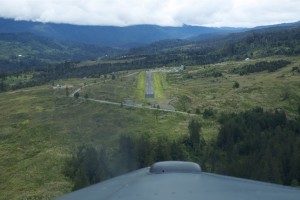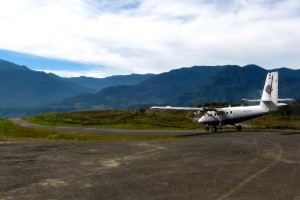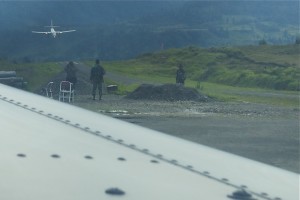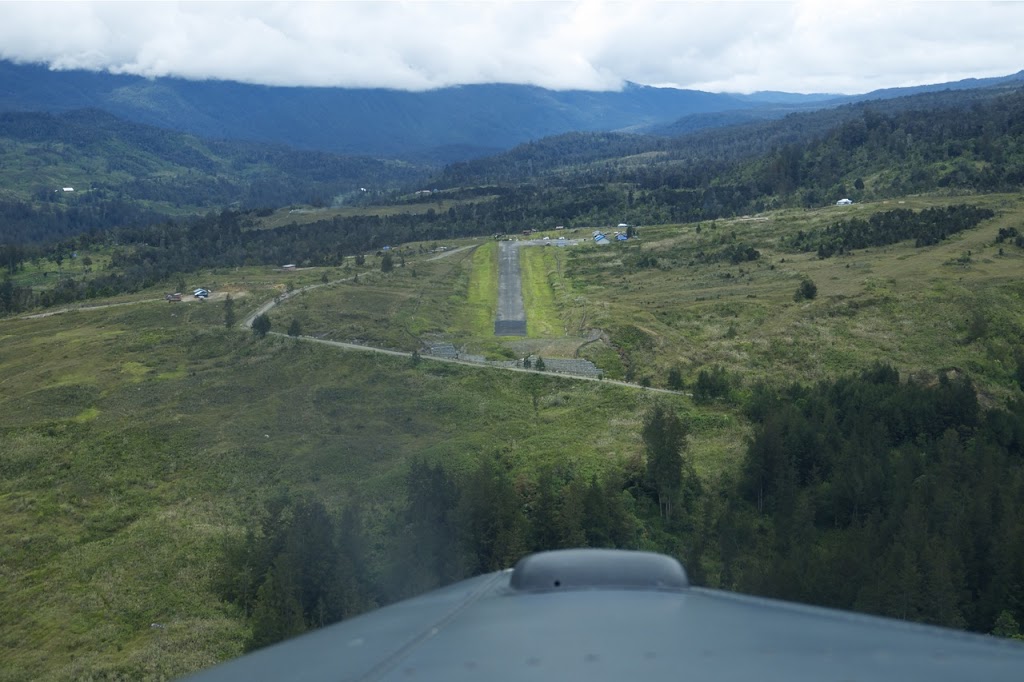Ilaga can be considered the capital town of the Puncak Jaya region of Papua, Indonesia. Located almost centrally in the Papuan mountain ranges, it’s one of the busiest mountain airstrips we fly to. It’s not uncommon to arrive early morning to find four or five other aircraft from all over the province delivering supplies to the mountain people.
 |
| Final approach runway 25, Ilaga, Papua |
Runway statistics
Orientation: 25/07 (Landing 25, take-off 07)
Length: 600m
Elevation: 7500ft
Slope: average 4%
Surface: sealed tarmac, soft and broken in places
 |
| Trigana Twin Otter departing Ilaga, Papua |
Pilot notes
Although not especially difficult to operate a Porter in and out of, Ilaga can still provide some challenging conditions which one needs to be aware of. Thanks to it’s location in a large bowl surrounded by higher terrain, early morning fog often shrouds the bowl and by late morning the wind really picks up, blowing up the slopes. Due to the runway’s alignment to the terrain, this produces a gusting left cross/tail wind on approach that can make landing pretty tricky after midday. I tend to favour flying the approach with 5-10kts extra airspeed when it’s really gusty, as it’s not unusual to get some windshear just as you approach the threshold.
The runway surface conditions are also not too good with a few undulations and a slight side slope to the right just off the centre of the runway. Land slightly right of centreline (which can happen if a gust of wind catches you during the flare) and it can take some quick rudder work to bring the Porter back to the centre.
Departure is pretty straight forward and the combination of down-slope and headwind allow for a standard rolling departure in the Porter. The large bowl allows for a decent enough climb-out in-between the terrain to climb up and over the ridges and continue en-route.
 |
| Trigana Caribou on approach into Ilaga, Papua |
Everything written in this article are opinions of the author and should not be taken as sole reference for attempting a flight into or out of the aforementioned airstrip
Discover more from Matt Dearden
Subscribe to get the latest posts sent to your email.

Why do those people have automatic weapons? Is it dangerous there?
Andrius
It’s not usually dangerous to us pilots. The fighting is usually between one of the local separatist movements and the Indonesian military and police forces. If there are any reports of fighting in a particular area, we will suspect all flights to airstrips in that area until it is made safe again. Sometimes this can take months which can be very hard on the local people who are effectively cut-off once air transport stops.
May I point out Ilaga is not in West Papua? The province of West Papua is the Bird’s Head area (Kaimana, Babo, Fak-Fak, Sorong, Manokwari, Wasior). The remainder of Indonesian New Guinea is the province of Papua.
You are quite right and I’ve corrected the article accordingly. The naming of the province has always caused confusion, so I apologise!
Dear Matt, i follow your blog everyweek and i am always looking for new updates, also your pictures are amazing as i am a great ocean/jungle lover. I am an “old” CPL pilot and if you have time and will i would like to ask you some questions about Susi Air! Please email me at: cobrocci@gmail.com
Riccardo
Check your emails Riccardo.
Matt!!
firstly your blog it’s just great. I am a young pilot from poland with experience on Cessna 206 soloy turbine, I have some questions to you, I’ll be glad if you mail me at : mierzejewski65@o2.pl
Regards
Łukasz M.
I’ve sent you an email Lukasz.
Hi Matt, just subscribed. Great photos and fascinating blog! I’ll be in Papua soon (and have flown Susi in the past around the highlands) I would be really grateful if you’d drop me a line. Quick question! Cheers
ATB
papuatrans@gmail.com
Done. Let me know!
Hi Matt, do you enjoy flying the 208 Caravan or the Pilatus PC-6 more?
Easy question, PC-6!
Why do you like the PC-6 more? By the way, I used to live in Timika but then my family and I moved to Jayapura. I really loved it in Timika.
The PC-6 can land on pretty much anything you dare to call an airstrip. I enjoy the challenge of operating into and out of such airstrips. The PC-6 also has a much better rate of climb than the C208 which is very useful when flying into and out of steeply sided valleys.
When i grow up I would like to fly the Porter in Papua.
It’s a great aircraft :o)